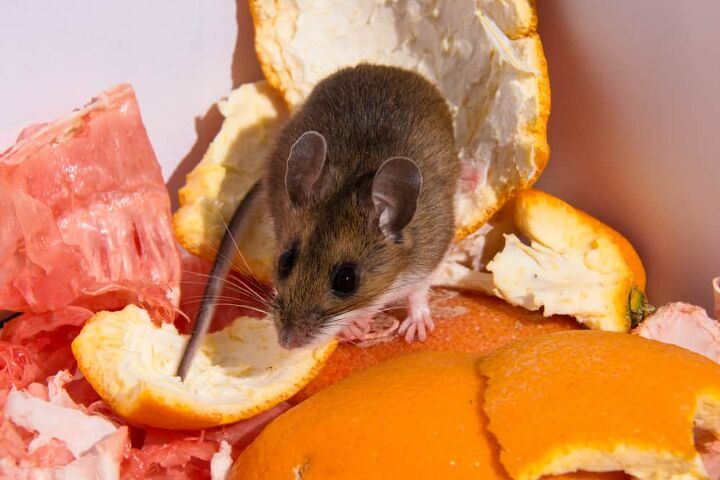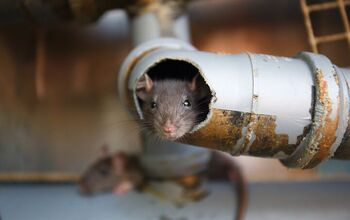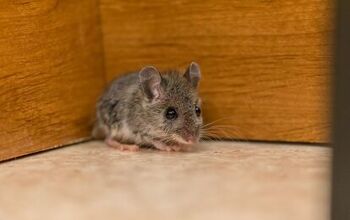Can Mice Get Into A Refrigerator? (Find Out Now!)

If you’ve ever wondered if mice can get into your refrigerator, you may be surprised at the answer. While refrigerators are made from metal and can successfully ward off many different types of critters, mice are clever and can find a way in.
Mice can get into your refrigerator through just about any weak point that they find. Usually, the most vulnerable point on a refrigerator is the seal around the door. When the seal begins to break down, or if a mouse is clever enough to chew through it, mice can get into a refrigerator.
How Do Mice Get Into Refrigerators?
There are a few different ways that mice can get into refrigerators. While the most common way is through a hole or tear on the seal surrounding the door, it is also possible for mice to get into a refrigerator through the plumbing and refrigeration system.
Plumbing and Airflow
Drainage pipes and fan openings on the back wall of the interior part of the refrigerator lead to the compressor, motor, and other parts of the fridge that keep everything working.
These openings are usually covered by some kind of grate (usually plastic) which means that mice cannot get in under normal circumstances. However, mice can create abnormal circumstances with their incredibly effective teeth.
If mice are determined enough, they can gnaw through soft materials like plastic. With enough time, they can create holes in many different materials which they then crawl through.
Cavity Liner
Another possibility is that the mice can get in through the cavity liner. It is somewhat rare for mice to utilize this method but when hungry they will try just about anything to get to a food source.
To get through the cavity liner, mice must first find a way in between the outer shell and the liner (the part that you see when you open the fridge). There is no way for mice to chew through the outer shell as it is made from metal, but the inner shell can be made from softer materials.
If the cavity liner in your fridge is made from a plastic, mice can get through it. Fortunately, troubleshooting this type of problem is relatively simple. Take everything out of the fridge and inspect the interior for holes and other possible points of entry.
Mouse Anatomy
The anatomy of a mouse is important to understand when you are looking for ways that a mouse can get into your refrigerator.
Mice come in many sizes, but small describes them well in any case. Apart from being small, however, mice have a few tricks up their sleeves that make accessing difficult areas (like the inside of a refrigerator) possible.
Skeletal StructureWhen you are looking for possible entry points for a mouse to get into your home or fridge, keep in mind that many people believe that mice have collapsible skeletons. These same people also think that mice can flatten their bodies at will, allowing them to squeeze through extremely tight spaces.
While these beliefs are untrue, there is good reason for that belief to exist. When observing mice, it certainly seems as if they do not have any bones at all!
The flexibility in their ribs and skulls allows mice to fit into exceedingly small spaces. And, although their skeletons are not collapsible, it sure like they are. Because of the unique features of their bones and bone structures, mice can fit through any opening that their heads can fit into.
To help identify holes and openings in your house that a mouse can fit through, watch the following video.
Mice also have another anatomical feature that makes it easy for them to climb: their hands. Mice have a combination of fingers and pads which work together to help the rodents with all kinds of climbing and acrobatic tricks! The pads allow them to grip onto smooth surfaces and their fingers are capable of grabbing and holding onto ledges, pipes, and many other things.
Keeping Mice Out of Your Refrigerator
To keep mice out of your refrigerator, there are a couple of things that you can do. The first is to check all the possible entry points that a mouse could get into your home. After all, if they are not in your home, you will not have to worry about mice in your refrigerator.
Locate Entry Points Into Your Home
To start, think like a mouse! With the fact that mice can squeeze themselves into very small spaces firmly in mind, you’ll have to search windows, walls, doors, and all the areas between for cracks, holes, and any other area that a mouse could fit into.
If any potential entry points are discovered, you will need to repair them. A quick fix is to fill any access points with wire mesh or a wad of cotton that has been doused in peppermint oil. Temporarily fixing the problem will help keep the mice out while you prepare the necessary materials to fix whatever holes or cracks exist.
Sealing Your Refrigerator
Depending on how the mice are getting into your refrigerator, the method that you use to seal off any entry points within your refrigerator will change.
Defrost Drain Access: For example, if mice are getting though the defrost drain (a hole that is about the diameter of a pencil), it is important to cover that drain pipe with something that does not hinder the functionality of the drain. Possible solutions include adhering a metal mesh over the drainpipe.
Alternatively, you can use steel wool to fill the end of the pipe and mice will not be able to chew through that.
Door Seal: If you have discovered a problem with the door seal, you have a couple of different options. The easiest option is to replace the seal with a new one. Installing a new door seal will not only ensure that mice cannot get into the refrigerator, but the new seal will also improve your energy efficiency.
Cavity Liner: If the mice are getting into the fridge through the cavity liner, the problem and solution should be fairly obvious. A hole in the lining of the interior of the fridge should be easy to see due to the light color of the material.
Covering a hole in the cavity liner of your fridge can be as simple as gluing a piece of plastic over the hole to create a patch.
Things to keep in mind when repairing a hole in the cavity liner are that some types of glue work better than others in cold environments (read packaging) and that the plastic that you use to create a patch should be strong enough to keep cold air in.
Related Questions
Can mice live in the back of a refrigerator?
Yes, mice can certainly live in the back of a refrigerator. Mice enjoy the warmth of the compressor and the shell of the refrigerator provides mice with a safe home that is dark and comfortable.Depending on the type of fridge in question, mice can crawl into the back of the appliance through the bottom or the grate on the back.
How do you keep mice out of appliances?
There are numerous chemical agents available to help prevent mice from entering appliances but there are also some simple home remedies that you may try. The most popular method is placing cotton balls soaked with peppermint oil along the entry points that mice would use. Mice do not like the smell of peppermint and will stay away.
Related Guides

Benjamin is a proud homeowner who loves to write about DIY projects and home improvement projects. Traveling, perfecting his home, and spending time with his family are just a few of the many things that keep him inspired.
More by Benjamin Wright



























